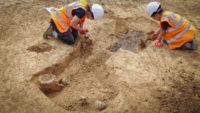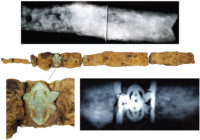 A rare Iron Age grave furnished with weapons has been discovered in Walberton, West Sussex. The site of a future housing development was being excavated by a team from Archaeology South-East (ASE) when they unearthed the grave dating to between the Late Iron Age and the early Roman era (1st century B.C. – 50 A.D.).
A rare Iron Age grave furnished with weapons has been discovered in Walberton, West Sussex. The site of a future housing development was being excavated by a team from Archaeology South-East (ASE) when they unearthed the grave dating to between the Late Iron Age and the early Roman era (1st century B.C. – 50 A.D.).
No human remains were found, disintegrated over time in unwelcoming soil. A roughly rectangular dark stain on the soil is all that’s left of the wooden bed or container that the deceased was interred on or in. At one of the short ends of this stain, just outside its perimenter but well-within the grave itself, were four pottery vessels made from local clay. They are utilitarian items, of a type that would have been used to make and store food in the 1st century. Between two of them was a spearhead. At the other end of the grave were additional metal pieces, their form and function currently unknown.
 Along the long side of the stain there was an iron sword inside a scabbard made of an organic material (as yet unidentifed). The scabbard was decorated with a copper alloy mount at the mouth. Initial conservation and X-rays of the sword reveal the mount was an elaborate, detailed ornament that would have stood out dramatically when worn.
Along the long side of the stain there was an iron sword inside a scabbard made of an organic material (as yet unidentifed). The scabbard was decorated with a copper alloy mount at the mouth. Initial conservation and X-rays of the sword reveal the mount was an elaborate, detailed ornament that would have stood out dramatically when worn.
Warrior burials from this period are extremely rare in Sussex, and with so little data to go on, their cultural significance is unclear.
Jim Stevenson, the ASE archaeologist who is managing the post-excavation investigations into the burial, said: “There has been much discussion generally as to who the people buried in the ‘warrior’ tradition may have been in life.
“Were they really warriors, or just buried with the trappings of one?
“Although the soil conditions destroyed the skeleton, the items discovered within the grave suggest that the occupant had been an important individual.”
Studies of the grave and its contents are ongoing.